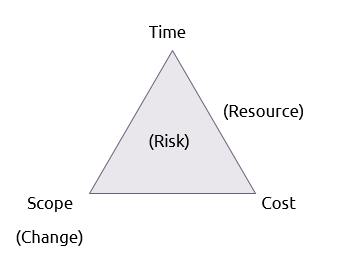The triple constraint is one of the fundamental truths of P3 Management. Also known as the ‘iron triangle’, it has spawned many variations but these often dilute the impact of the original.
 In its simplest form the triangle shows the relationship between the objectives of the work (scope), the time it will take to produce them and how much it will cost to complete the work.
In its simplest form the triangle shows the relationship between the objectives of the work (scope), the time it will take to produce them and how much it will cost to complete the work.
The significance of the triangle is that it is the most stable geometric shape and emphasises that any attempt to make changes to one corner of the triangle will have an immediate impact on the other two.
This is hardly a new concept. Over 150 years ago, John Ruskin said:
“The common law of business balance prohibits paying a little and getting a lot - it can't be done.”
The beauty of the triangle is that is illustrates this, and other connections very simply. If you increase the scope it will take longer and cost more; if you restrict the budget you will have to settle for lower scope; restricting the timescale will increase costs.
While these relationships are common sense, they are often overlooked in a ‘conspiracy of optimism’ during requirements management and planning. One of the annoyances of detailed planning is that it often tells stakeholders what they didn’t want to know, i.e. “you can’t have that output by then if that’s all you are prepared to pay”. This is simply a consequence of the triple constraint.
The principles of the triple constraint as they affect a project or programme have to be established early in the life cycle. Projects and programmes will have different degrees of sensitivity to changes in one of the three constraints. More mature organisations will understand this and may well document it in the business case.
The Praxis delivery functions address these three constraints in scope management, schedule management and financial management, but Praxis also identifies three other “fundamental components’ of delivery: risk, change and resource.
 Rather than extend the model to be a hexagon or overlapping triangles it is better to understand the relationship between the first three and the second three components.
Rather than extend the model to be a hexagon or overlapping triangles it is better to understand the relationship between the first three and the second three components.
Change is primarily related to scope. It is necessary for the achievement of benefits and will affect time and cost through that relationship.
Change management will seek to achieve the necessary change within the constraints of time and cost.
Risk is related to all three corners of the triangle and risk management should assess how any specific risk event will impact on each of the three corners.
Resource is most directly related to time and cost, and resource management is concerned with sourcing resources that can perform the required work on time at an acceptable cost.





